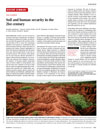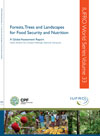-
Soil Security and Incorporating Forestry Into Food Security Strategies
July 2, 2015 By Josh Feng Earth’s thin upper-crust of soil is kept in balance by a complex carbon and nutrient cycle that is increasingly threatened by human exploitation and climate change, according to a review in Science. The chemicals trapped in topsoil and subsoil are crucial to plant growth, but are being depleted at rates much higher than they are being replenished, writes Ronald Amundson et al. For instance in the central United States, estimated soil erosion rates exceed production rates by 10 times. Though energy-intensive, artificial nitrogen replenishment is widespread, rock-derived nutrients such as phosphorus, potassium, and calcium are much more difficult to obtain. The race for these resources may spur geopolitical tension and economic inequality if depletion continues unabated, the authors warn. Anthropogenic climate change compound these threats, as increasing temperatures may trigger positive feedback processes in the soil mantle (a large carbon sink), exacerbating an already warming climate. The authors conclude with a call for better soil management strategies as an integral part of any solution to achieve food security and combat climate change.
Earth’s thin upper-crust of soil is kept in balance by a complex carbon and nutrient cycle that is increasingly threatened by human exploitation and climate change, according to a review in Science. The chemicals trapped in topsoil and subsoil are crucial to plant growth, but are being depleted at rates much higher than they are being replenished, writes Ronald Amundson et al. For instance in the central United States, estimated soil erosion rates exceed production rates by 10 times. Though energy-intensive, artificial nitrogen replenishment is widespread, rock-derived nutrients such as phosphorus, potassium, and calcium are much more difficult to obtain. The race for these resources may spur geopolitical tension and economic inequality if depletion continues unabated, the authors warn. Anthropogenic climate change compound these threats, as increasing temperatures may trigger positive feedback processes in the soil mantle (a large carbon sink), exacerbating an already warming climate. The authors conclude with a call for better soil management strategies as an integral part of any solution to achieve food security and combat climate change. A global assessment of the role of forests and trees on food security and nutrition, published by the International Union of Forest Research Organizations, proposes forest management should be a more integral part of global food security strategies. The authors explain how agroforestry techniques can be both restorative and productive for ecosystems. “Working with farmers to combine the best of traditional and formal scientific knowledge offers tremendous potential to enhance the productivity and resilience of these systems and the flow of direct (food security and nutrition) and indirect (income) benefits to their practitioners,” they write. The report cites a UN Development Program initiative in Tajikistan that mobilized communities surrounding the Gissar Mountains as a successful example of this cooperation. Integrating local communities into the decision-making process can restructure governance to create more inclusive food systems as well. The report suggests targeted agroforestry initiatives can help address unequal access to resources among women and disadvantaged groups.
A global assessment of the role of forests and trees on food security and nutrition, published by the International Union of Forest Research Organizations, proposes forest management should be a more integral part of global food security strategies. The authors explain how agroforestry techniques can be both restorative and productive for ecosystems. “Working with farmers to combine the best of traditional and formal scientific knowledge offers tremendous potential to enhance the productivity and resilience of these systems and the flow of direct (food security and nutrition) and indirect (income) benefits to their practitioners,” they write. The report cites a UN Development Program initiative in Tajikistan that mobilized communities surrounding the Gissar Mountains as a successful example of this cooperation. Integrating local communities into the decision-making process can restructure governance to create more inclusive food systems as well. The report suggests targeted agroforestry initiatives can help address unequal access to resources among women and disadvantaged groups.Sources: International Union of Forest Research Organizations, Science.
 A Publication of the Stimson Center.
A Publication of the Stimson Center.





